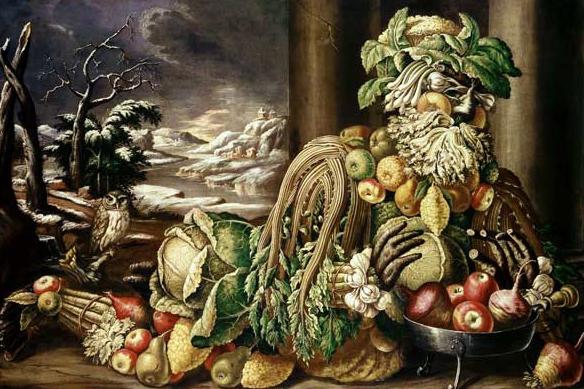The Italian artist Archimboldo Giuseppe (1528-1593), reopened to the general public only in 1885, is considered a forgotten Renaissance genius. It is compared with Leonardo da Vinci. The range of interests of both was incredibly wide: they were encyclopedists, both left the masterpieces of painting to descendants and both were forgotten by descendants. Da Vinci was remembered much earlier. There are other parallels - both geniuses of recognition and money have achieved themselves in life. It can be added that their fathers were artists.
Minion of fate
Arcimboldo Giuseppe, whose paintings aroused interest among royalty, for a long time (about 25 years) was a court artist of the Habsburgs. With Rudolph II, he had a personal friendship. Engineer, naturalist, astrologer, organizer of the Kunstkamera, he personally was engaged in the replenishment of the royal collections. The high honor shown to him by the court is evidenced by the fact that in 1592 Giuseppe Archibaldo was granted the title of nobility with the right to his own coat of arms and the position of the palatine governor of the royal palace in the absence of the owner.
First among equals
Only three artists in the Holy Roman Empire were awarded this rank - Vercelli Sodoma, Vecellio Titian and Archimboldo Giuseppe. The artist’s paintings caused controversy during his lifetime. Someone said that this was the fruit of his sick imagination, inspired by the Kunstkamera, someone liked the paintings very much and considered the artist an experimenter. In any case, his later paintings represented something new, completely unfamiliar. Contemporaries ranked him, like Sodom, among the mannerists. What it is? This is the literary and artistic direction of the late Renaissance, characterized by the loss of high ideals of the Renaissance. There is no harmony between the spiritual and bodily nature of man. Pretentiousness is inherent in mannerism.
Unique heritage
The artist painted canvases in the classical style, but many works were lost, three were preserved, written according to all the canons of painting - with the image of worshiping Magi, a portrait of the princess and a
family portrait of the first patron of the artist Maximilian II. It is also bad that Archimboldo Giuseppe, whose paintings are now in the amount of 20 pieces, did not leave any personal certificates after himself, either about himself or about his canvases. Interest in him flared up after the publication of the monograph of art critic K. Kasati in 1885.
The uniqueness of each painting
Among the small heritage, mysterious and unique chest portraits attracted attention. People on them were, as it were, assembled from various things, which is why they are often called the orgy of nature. But the fact is that there are no random objects on the canvases. A portrait of a librarian consists only of things available in the reading room. The canvas is included in the cycle "Profession". There are three more paintings-shifter, the cycle “Four Elements”, “Seasons” and the seasons “The Seasons”, preserved in the largest number in the entire heritage of Arcimboldo Giuseppe, with all seasons painted in several versions. The largest number of paintings called "Spring". These works are so unusual that we can fully explain the interest that flared up in them.
Deserved Demand
What definitions these paintings did not deserve, with which they were not compared. In the first half of the 20th century, in 1920, such a direction in painting arose as surrealism, depicting a deformed reality, peculiar waking dreams. Arcimboldo was considered the forerunner of this movement. Although his portraits contain more natural philosophy than dreams, and the forerunner of surrealism was Jerome Bosch, who has a deformed reality and dreams!

Arcimboldo Giuseppe, whose paintings are simply executed in a very interesting manner, is the founder of an as yet undisclosed direction. His style is gaining more and more followers and supporters. As noted above, portraits consist of objects characteristic of the stated theme - only things that occur naturally in nature at this time correspond to each season. And if the picture is called a “changeling”, then the portraits are visible from one side and the other. Everything is selected clearly and in accordance with each other. Very original and wonderful master!